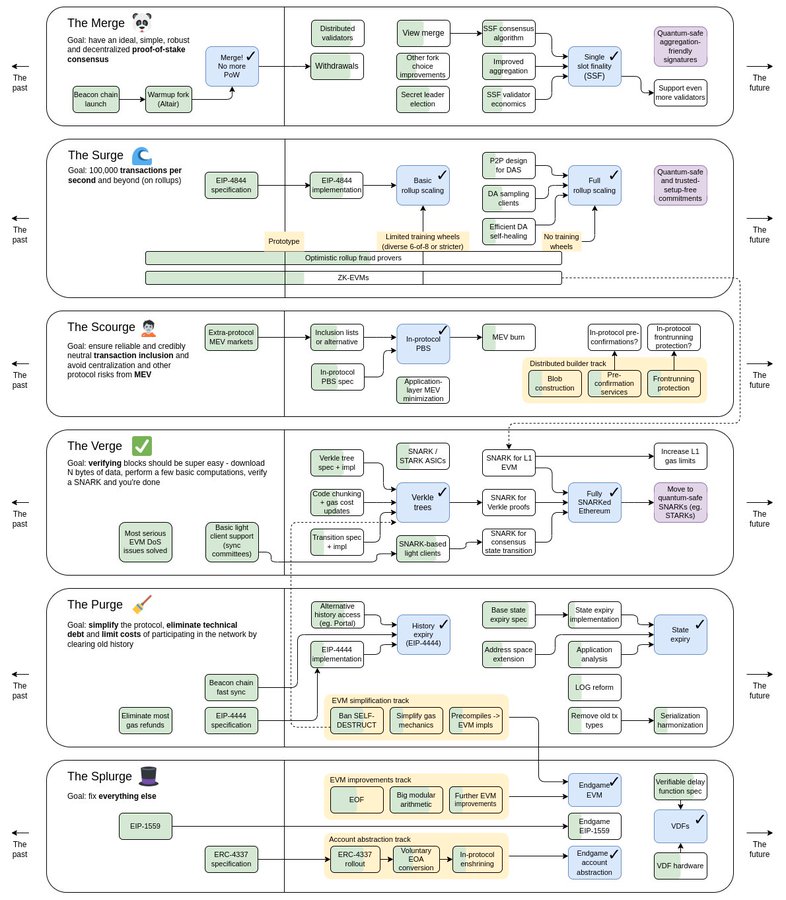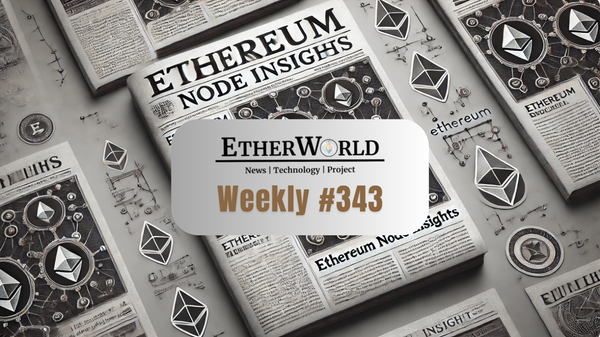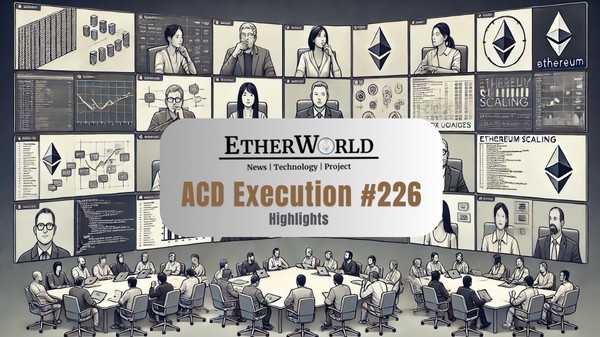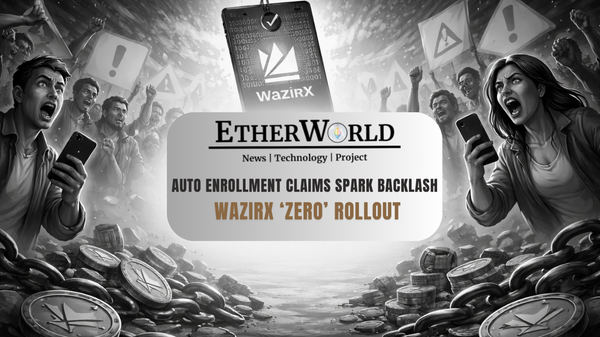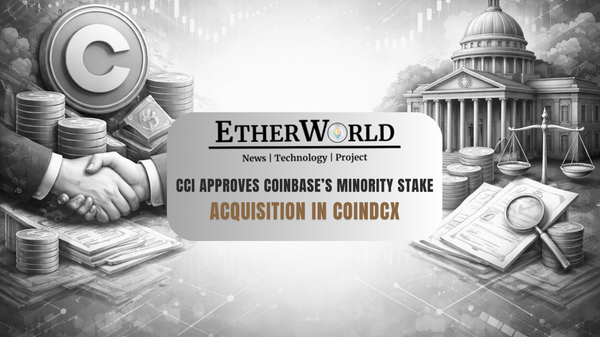Ethereum Foundation Research team organized the 9th edition of AMA (Ask Me Anything) Series on Reddit. This is the first developers AMA of 2023 featuring Ethereum Roadmap & Network Upgrades . Ethereum developers also discussed Privacy , Adoption and MEV. In this article, we will look at the best questions and responses shared by the EF Research team.
Roadmap
What parts of the Roadmap should Ethereum developers focus on once Withdrawals and EIP-4844 are released?
According to Vitalik Buterin, Wallet Security (mainly through EIP-4337 & Account Abstraction) and Privacy (through ZK Privacy Solutions & Stealth Addresses) are the two main non-scaling related problems. Otherwise, he would love to see a massive push towards making it cheaper to verify the chain, i.e., the central theme of The Verge.
EF Researcher Justin Drake thinks a broader context will drive this prioritization.
- If relay censorship remains acute, focus on shipping enshrined proposer-builder separation.
- If proposers get DoSed, focus on shipping the secret leading election.
- If too much ETH gets staked, focus on capping the active validator set.
- If Ethereum suffers frequent reorgs, focus on single-slot finality.
- If RANDAO gets abused, focus on verifiable delays functions.
- If MEV variance leads to significant pooling, focus on MEV burn.
- If EIP-4844 blobspace becomes too expensive, focus on danksharding.
This question was asked by Reddit user Ivo_ChainNET.
Network Upgrades
With EIP-4844, if data is deleted after a month, how can the subsequent transactions be validated?
This is a common misunderstanding of data availability. An Ethereum block is said to have been available if anyone who wanted to download the block around the time the block was published could have done so. Also, data availability is not about the downloadability of the block after the block was published; that's data storage and retrievability.
The good news is that data storage and retrievability is easy, as we need one entity in the world to store and serve the data after it's been made available. Whether or not this data is stored by Ethereum full nodes and retrieved via the Ethereum p2p network is a relatively minor implementation detail.
This data can be stored and retrieved anywhere and by anyone, including on BitTorrent, on IPFS with Filecoin, on Portal, and even on centralized servers owned by explorers, exchanges, rollups operators, archivists, enthusiasts, etc. So again, we only need one entity to store and serve the Ethereum history for long-term retrievability. The "instantaneous" property of data availability is the hard part.
This question was asked by Reddit user AllwaysBuyCheap.
Do you guys think that when rollups can process dozens of thousands of transactions in the future, some of them may offer free tiers? (for example, on Optimism, the first ten transactions each month are free).
According to Vitalik Buterin, this is a great use case for something like UBI Coin. Realistically, such projects, unfortunately, will not be able to get the economic scale to offer people enough coins to pay for food and healthcare, especially if they succeed at scaling to many millions of people.
Still, they will be able to give a UBI large enough to cover people's transaction fees. Furthermore, this could make Ethereum non-financial apps (e.g., ENS, SIWE, POAPs) significantly more accessible to many people worldwide who do not have easy access to cryptocurrency exchanges.
This question was asked by Reddit user AllwaysBuyCheap.
What is the current roadmap for limiting the number of (active) validators?
Vitalik Buterin has written writeups presenting two classes of ideas: super committees and validator set size capping.
This question was asked by Reddit user Rapante.
What are your best learnings (pros & cons) from The Merge that developers will carry forward to future milestones?
Complexity is evil. Testing is paramount. Reduce complexity at almost all costs. Modularize where possible. Also engineering takes time.
This question was asked by Reddit user BullishBear.
Will any security features be enabled when Withdrawals are enabled to make Ethereum Secure?
Readers can take a look at EIP-4736 and Consensus Layer Withdrawal Protection. EIP-4736 adds additional security for a change withdrawal address operation when a consensus layer mnemonic is compromised without changing consensus. In addition, users can submit a pull request with their Ethereum validator change withdrawal credential message to have the CLWP community broadcast it as early as possible for security.
This question was asked by Reddit user c0hnj0ltrane.
Privacy
How will privacy be addressed in Ethereum's long-term future?
Because private VMs (e.g. Aztec) and private applications (e.g., Tornado Cash) can be built on top of the EVM, there is no need for the L1 EVM to provide functionality tailored to privacy. As a side note, privacy tools are used sparingly within the L1. Two exceptions are:
- secret leader elections, which preserve the privacy of the next block proposer until their block is proposed
- encrypted mempools that preserve transaction payload privacy until inclusion on-chain.
This question was asked by Reddit user Njaa.
Would encrypted mempools mean builders and proposers wouldn't even know what they include in a block?
At a first approximation, the Answer is Yes. Encrypted mempool R&D is progressing fast. See this recording and slides. Arbitrum and Shutter have designs based on threshold encryption, FlashBots has an SGX design, i.e., SUAVE, and StarkWare has played with time-based encryption, i.e., VeeDo.
This question was asked by Reddit user Njaa.
Adoption
How can Ethereum help a person who finds his bank extremely trustworthy, and his payment app is perfect, scans QR codes, has zero fees, and instant transactions?
Ethereum allows for permissionless innovation. According to Vitalik Buterin, there are some practical ways of using Ethereum:
- International Charity Donations
- Purchases of Plane tickets & Saving on International Credit Card Fees
- Privacy-Preserving Purchases of VPN subscriptions
Also, no. of use cases will increase with respect to time.
This question was asked by Reddit user Liberosist.
What year do you estimate that the average consumer will use cheap/frictionless payments on L2 with similar ease as ‘tap to pay’ or Apple Pay?
Layer 2 usage will ramp up substantially over the next couple of years. The competition and business development amongst the teams might become fierce as they try to onboard non-crypto-native applications and users. At that point, blockchain applications will be increasingly "normal" for younger generations. Then over the next 2 to 4 years, bigger applications will continue to adopt. This will take around ~5 to 8 years.
This question was asked by Reddit user dabupa.
What steps are you guys taking in consideration for Ethereum to become more like the "new Internet" and not so much like Linux?
If Ethereum wants to have a fighting chance of winning significant end-user market share, then it needs to solve three big problems:
- Scaling, i.e., making cheap transactions for billions of people.
- UX, i.e., allowing people to use crypto easily.
- Stability, i.e., allowing people to hold at least somewhat stable assets in their blockchain portfolios.
Ethereum has made a good amount of progress on all three. However, even if they are solved, it still takes people building really good apps and marketing them well for them to succeed.
This question was asked by Reddit user petry66.
MEV
Do you guys think there is a viable solution for the MEV censorship problem, or do we have to accept that x% of the validators will always comply with the US sanctions?
Inclusion lists are a fantastic tool for that. They will allow non-censoring validators to impose their view of the mempool on the censoring validators to a point where it's economically unrealistic to prevent a transaction in the inclusion list from being included on-chain within a few blocks.
A censoring builder would have to continuously burn exponentially more of their ETH to keep outbidding non-censoring builders, and censoring validators will miss out on MEV present in non-censoring blocks if they don't want to propose that block (with the burn auction proposed in MEV burn, they will always get outbid, unless they're willing to burn more, which makes no sense economically). Eventually, the cost of censoring transactions will far outweigh the rewards of validating and block building, so censoring parties will not participate.
This question was asked by Reddit user AllwaysBuyCheap.
What is the current status of MEV burn, and when do you expect it to go live? Do you expect pushback from stakers similar to what miners did to block rewards reduction and the merge?
According to the response by from EF Research Team, Developers want to do Proposer Builder Separation (PBS) first, then a proper MEV burn design. Also, burning the MEV doesn't affect per-validator APR.
This question was asked by Reddit user HongKongCrypto.
Related Videos
- MEV Part 2: DEX Arbitrage, Time Bandit Attacks, Uncle Bandit Attacks & NFT MEV
- TWAMM: Time-Weighted Average Market Maker
- MobyMask: An Initiative to Eliminate Phishers
- Fractional NFTs: EIP-4675 using EIP-1155 & EIP-1633
- Web3 Limitations
- Web 1 to Web 3
- Ethereum Transaction Lifecycle
- What is an Ethereum Transaction?
- Externally Owned Accounts (EOAs) Vs Contract Accounts
- What is an Ethereum Account?
Related Articles
- Transient Storage for Beginners: EIP-1153 Explained
- How Layer 3 in Future will look like?
- An Overview of Beacon Chain API
Disclaimer: The information contained on this web page is for education purposes only. Readers are suggested to conduct their own research, review, analyze and verify the content before relying on them.
To publish press releases, project updates and guest posts with us, please email at contact@etherworld.co.
Subscribe to EtherWorld YouTube channel for ELI5 content.
Support us at Gitcoin
You've something to share with the blockchain community, join us on Discord!



